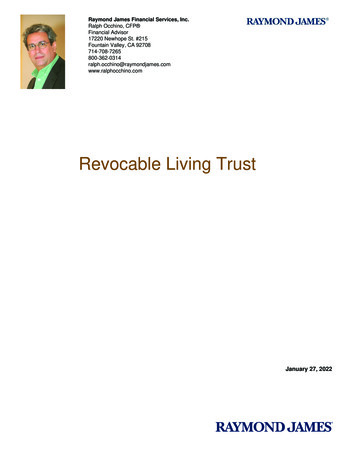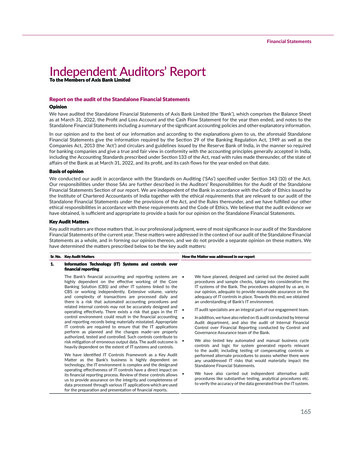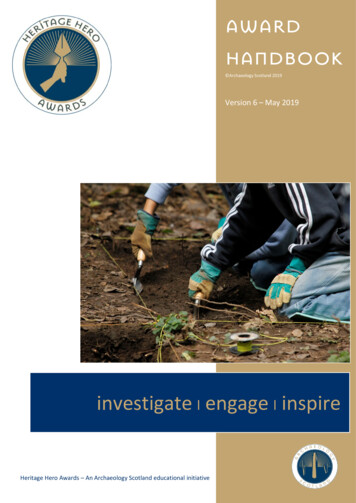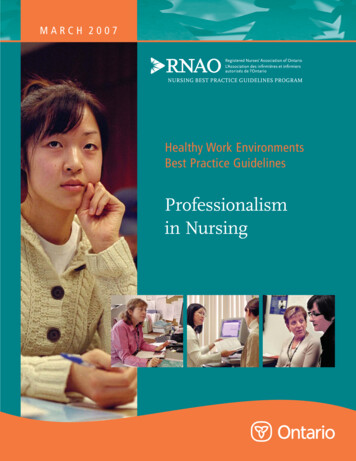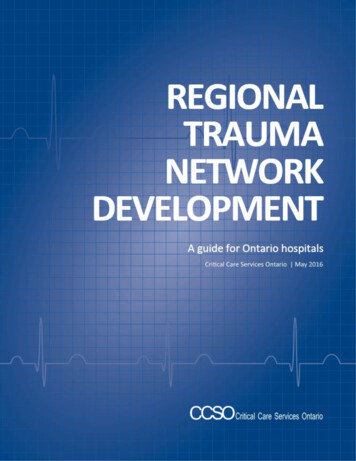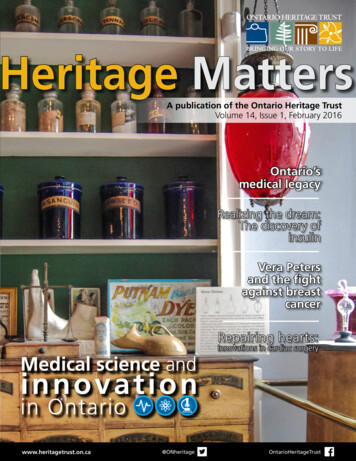
Transcription
Heritage MattersA publication of the Ontario Heritage TrustVolume 14, Issue 1, February 2016Ontario’smedical legacyRealizing the dream:The discovery ofinsulinVera Petersand the fightagainst breastcancerRepairing hearts:Innovations in cardiac ritageTrust
An enduring legacyOntario has contributed much to the worldin the field of medical science. Advancementsin cancer treatment, heart surgery and stemcell research are just three examples. Theseachievements – and the men and womenwho made them – are part of the very fabricof our society. This fascinating topic is closelyconnected to the history of compassion,education and community building.For thousands of years, informed by traditional ways of knowing, FirstNations peoples treated illness with natural remedies and physicalprocedures – like massage, sweat lodges and baths. Often linked tospiritual beliefs, these medical traditions were part of life and community,passed on verbally from one generation to the next. Much of this was,and continues to be, based on the medicine wheel that symbolizesthe interconnection of all parts of life – spiritual, physical, mental andemotional – the cycles of nature and the circular journey of life.With the arrival of the Europeans to Ontario came new contagiousdiseases and western medicine, with its contrasting linear world viewand scientific approach. But medicine in the colonial era was nothinglike what we know today. Pharmaceutical science was in its infancy: theexistence of germs as agents of disease was unknown, and bloodlettingto balance the humours was still a common treatment for illness.In the late 18th and for much of the 19th centuries, medical professionalswere educated abroad. This fact began to change with the establishmentof medical schools, first in St. Thomas in 1824 and then in Toronto in1843. Many of Ontario’s hospitals and medical institutions have theirroots in the 19th century, including the College of Physicians andSurgeons of Ontario (1869), the Ontario College of Pharmacists (1871),The Hospital for Sick Children (1875) and the Ontario Provincial Board ofHealth (1882).Today, Ontario is home to many globally significant research institutionsand hospital networks, six medical schools, a range of professionalassociations and advocacy groups that strive to continue to improvehealth care in Ontario and beyond. These institutions have had a lastingimpact on community development, research and education, contributingto an enduring legacy.I invite you to join us on this journey of discovery about medical scienceand innovation. You can learn more about our achievements in thisfield and the ingenious individuals involved by taking part in events,and by visiting museums and historical sites across the province. DoorsOpen Ontario 2016 will also showcase medical science and innovation.Many hospitals, doctor’s homes/offices, university laboratories and otherfacilities will be included in Doors Open events as communities come tobetter understand the complex and ongoing history of health care andwell-being.Beth HannaCEO, Ontario Heritage TrustContentsOntario’s medical legacy, by Dr. Jacalyn Duffin 2 Doctors, discoveries and developments: Medical achievementsand health care in Ontario 7 Vera Peters and the fight against breast cancer, by Dr. Charles Hayter 11 Repairing hearts: Innovations in cardiac surgery, by Dr. Shelley McKellar 13 Indigenous traditional medicine 16 Blood-forming stem cells: An Ontario story, by Dr. Hans A. Messner 17 Realizing the dream: The discovery ofinsulin, by Michael Bliss 19 Resources 21This issue of Heritage Matters, published in English and French, has a combinedcirculation of 9,200. Archived copies of Heritage Matters are available on ourwebsite at www.heritagetrust.on.ca/hm.For information, contact:Ontario Heritage Trust10 Adelaide Street East, Suite 302Toronto, OntarioM5C 1J3Telephone: 416-325-5032Fax: 416-314-0744Email: marketing@heritagetrust.on.caWebsite: www.heritagetrust.on.caThe inclusion of any advertisement or insert in this publication does not implyor constitute an endorsement or acceptance by the Province of Ontario of anyof the advertisers, products or services advertised. The Ontario Heritage Trustis not responsible for errors, omissions or misrepresentations contained in anyadvertisement or insert.Publication Agreement Number 1738690E&OEISSN 1198-2454 (Print)ISSN 1911-446X (PDF/Online)02/16Aussi disponible en français. Queen’s Printer for Ontario, 2016 Ontario Heritage Trust, 2016Photos Ontario Heritage Trust, 2016, unless otherwise indicated.Produced by the Ontario Heritage Trust(an agency of the Ontario Ministry of Tourism, Culture and Sport).Editor Gordon Pim Graphic Designer Paul ArcariEditorial Committee: Beth Hanna, Sean Fraser, Paul Dempsey,Wayne Kelly and Alan WojcikThis publication is printed on recycled paper using vegetableoil-based inks. Help us protect our environment by passing alongor recycling this publication when you have no further need for it.Heritage MattersThe views and opinions expressed in this publication are those of the authorsand do not necessarily reflect the views and opinions of theOntario Heritage Trust or the Government of Ontario.Cover: Interior of the Niagara Apothecary, a Trust-ownedproperty in Niagara-on-the-Lake. Photo: Roser Martínez
Ontario’smedical heritageMany people haveheard of Bantingand Best and theirdiscovery of insulin,but fewer knowabout the largerteam of Ontarians,including Drs. Collipand MacLeod who, in 1922, helped develop this life-savingtreatment for diabetes. In fact, a good number of Ontario’smedical innovators remain little known outside their medicalprofessions and the scientific community. Working with ourpartners, the Trust plans to shed light on their contributionsas we celebrate Ontario’s history of medical scienceand innovation this year.The number of innovations in medicalscience and technology conceivedin Ontario is extensive, and thestories fascinating – includingdiscoveries and inventionsrelated to pharmaceuticals,medical procedures and devices.For instance, plastic surgeonDr. Ross Tilley used an innovativeand highly successful approachto burn management whileworking with wounded soldiersand airmen during the Second WorldWar. In the 1950s, Dr. Vera Petersproved that Hodgkin’s disease – and, later,breast cancer – could be effectively treated withradiation. Innovations in cardiac surgery, combined withthe invention of the pacemaker by Drs. Wilfred Bigelow andJohn Callaghan and engineer John Hopps continue to saveand improve countless lives throughout the world.The provision of universal health care represents anothersignificant aspect of our province’s medical legacy. Indeed,the public health insurance program is an integral part ofour identity as Canadians and Ontarians. This year marks the50th anniversary of publicly funded health care in Ontario,and the introduction of the national Medical Care Act inOttawa. In 1966, the Ontario government introduced theOntario Medical Services Insurance Plan, which created theprovince’s first universal health care system. As a result,every resident of the province is entitled to emergency andpreventive care, known as OHIP since 1972. In education as inpublic policy, there have been significant and often pioneeringdevelopments in Ontario.Messagefrom ourChairmanI trust that you will find the stories in this issueengaging, illuminating and meaningful, andthat they will engender a growing curiosityabout Ontario’s great innovations inmedical science. May I invite you toexamine the subject in more detailat the Museum of Health Care atKingston or the Canadian MedicalHall of Fame in London. While inLondon, you may wish to visit thehome of Sir Frederick Banting – aco-discoverer of insulin – or see hisdesk at the Ontario Science Centrein Toronto. At the Trust’s NiagaraApothecary and at Fulford Place inBrockville, you can also see special exhibitson medical heritage.There is much to see and learn about the legacy of medicalscience and innovation in Ontario – a rich and varied part ofour province’s heritage.Thomas H.B. SymonsC.C., O.Ont, FRSC, LLD, D.Litt., D.U., D.Cn.L., FRGS, KSSChairmanHeritage Matters 01
Ontario’smedical legacyBy Dr. Jacalyn DuffinIn the mid-19th century, a typical doctor ran a solopractice, often making house calls on horseback or bysleigh. Many treatments offered relief for symptoms, butcures belonged to nature. The spectre of infections –diphtheria, whooping cough, measles, scarlet fever andsmallpox – was ever present. Few specialists were available;a doctor delivered babies, set fractures, pulled teeth, mixedmedicines and comforted those in need. Many patientscould not pay medical bills and the concept of vacationshad yet to be invented. Much has changed in the last150 years.Until the later 19th century, most Ontario practitionersstudied in Britain or the United States. At least threemedical schools in Ontario, however, supplied skilledpractitioners to local communities: Duncombe’s inSt. Thomas (1824), Rolph’s School (1843) and King’sCollege (1843), both in Toronto. Physicians communicatedwith each other around the world through journals thatfeatured original research and reports of innovations.Through these journals, Ontario doctors were able to applythe great 19th-century discoveries – anesthesia by 1847,antisepsis by 1867 and germ theory by 1882. The latterprompted the creation of a formal department of publichealth and the rapid incorporation of microscopy andbacteriology into clinical practice and education.02 Heritage MattersBut some innovations are wholly Canadian, and manywere from Ontario. Arguably, the most famous was thediscovery of insulin by Drs. Frederick Banting, Charles Best,J. Bertram Collip and J.J.R. Macleod. Their achievementprovided an effective treatment (not cure) for a deadlydisease that was, and still is, all too common. For theirefforts, they won the 1923 Nobel Prize.By 1929, and for the next two decades, Best and hiscolleagues worked on finding safe uses for the bloodthinner heparin. Although it had not originally been aCanadian discovery, they championed its applicationsin treating phlebitis, gangrene and pulmonary embolus.Heparin also meant that blood could be kept from clottingon contact with instruments, making it an essential step inadvancing the possibilities of cardiac surgery.In Toronto, a surgical team led by Wilfred G. Bigelowworked to repair heart defects. They had to find a wayto decrease the body’s need for oxygen in order to stopthe heartbeat for short periods without damaging tissues.Inspired by the slowed metabolism of hibernating animals,they induced hypothermia to lower body temperature,allowing extra time for operating. This creative 1950stechnique was eventually superseded by the advent of theheart-lung bypass machine, which took over the job ofpumping blood while the heart was stopped.
Lyndhurst Lodge, a community-based rehabilitation centre, was established to assist Canadian veterans who had suffered spinal cordinjuries in the Second World War. Photo Courtesy of Spinal Cord Injury Ontario.The Second World War ravaged hundreds of youngadults. Hoping to rehabilitate spinal-cord-injured soldiers,neurosurgeon Edmund H. Botterell and physiatrist AlbinJousse created a special program at Toronto’s LyndhurstLodge in 1945. Their mission was to restore the disabledsoldiers to active life through physical and mentaltherapy. The focus expanded to include civilian patientswith other disabilities, and Lyndhurst eventually evolvedinto a major research institute for rehabilitation.In the care of mothers and children, several Ontarioinitiatives were firsts for Canada, if not the world.Elizabeth Bagshaw established a birth control clinic inHamilton in 1932. Vaccination of infants against theinfectious scourges of the previous century became arequirement for admission to public school. Additionally,Toronto’s Hospital for Sick Children witnessed the adventof brilliant surgical procedures for congenital heartdisease and dislocated hips.Following the observations of Pierre and Marie Curie,radioactive substances were soon applied to thetreatment of cancer. From the 1930s, the town of PortHope hosted the Eldorado Company for refining radium.Inserted into needles and other devices, radium treatedmalignant tumours in all parts of the body. The resultswere impressive. Its byproducts include uranium, whichled to Port Hope’s involvement in the Manhattan projectto produce the atomic bomb. Eldorado brought jobsand prosperity to Port Hope. Later, citizens learnedof the dangers of radiation, and following 20 yearsof controversy, radium production ceased. Uraniumproduction continues but the safe disposal of nuclearwaste remains a significant challenge.The province created the Ontario Cancer Treatment andResearch Foundation in 1943 (OCTRF, now Cancer CareOntario) to coordinate access to the new treatments ofradiation and chemotherapy, and to promote research.In 1951, under the auspices of the clinic in London,the province competed with Saskatchewan for the firstinstallation and use of a cobalt-60 unit. Whicheverprovince deserves that honour, Ontario succeeded inluring the brilliant teacher-scientist Harold E. Johns fromSaskatoon to Toronto, where he authored the definitivebook on radiation physics and inspired generations ofyoung physicists and doctors.A little-known Ontario achievement in cancer treatmentwas the 1958 isolation of vinca alkaloids from theperiwinkle plant in the London laboratory of RobertNoble, by his chemist, Charles Beer, and their assistant,Halina Robinson. Jamaicans had sent dried leaves ofthe vinca plant to Canada, hoping it would prove to bea source of oral insulin. Instead, its purified extracts –vinblastine and vincristine – became drugs that are stillwidely used and have long been recognized as a cure forchildhood leukemia.Heritage Matters 03
Another research achievement came in1963 from Ontario Cancer Institute (OCI)scientists James Till and Ernest McCullough,who identified stem cells. Among themultiple applications of their work are thescientific foundations of the bone marrowtransplantation developed by AmericanNobel laureate, E. Donnell Thomas. Decadeslater, OCI scientist Tak Mak cloned theT-cell receptor and pioneered research ingenetically altered mice. His achievementshave garnered multiple awards and inspiredthousands of scientists around the globe.The array of treatments and claims ofmanufacturers led McMaster’s David L.Sackett and Gordon H. Guyatt to arguefor a more judicious use of scientificinformation. They recommended careful useof randomized, controlled trials – preferablydouble-blind – to evaluate changes inmedical practice and construction ofguidelines. This movement came to be calledevidence-based medicine, a term coined byGuyatt in 1992. It now pervades all aspectsof clinical science on an international scale.The Gathering Area in the Sioux Lookout Meno Ya WinHealth Centre (SLMHC) is designed to suggest a clearing in aforest, a lodge or longhouse, with a fireplace that symbolizesunity with the community. Photo used with permission of theSLMHC.04 Heritage MattersCanada’s first training school for nurses, c. 1875 (St. Catharines).Canadian Museum of History, 2001-H0006.4, IMG2008-06330021.
Photo courtesy of the London Health Sciences Centre.Ontario also pioneered innovations in health-care delivery. For example, psychiatric hospital beds were reduced by80 per cent from 1960s levels; what had once been 16 residential homes for the mentally disabled were closed by 2009.Slow to conform to the Canada Health Act (1984) and following the 1986 doctors’ strike, the province made stridesin developing policies around hospital and home care that reflect local needs and wise use of resources. For example,between 1996 and 2000, the Health Services Restructuring Commission mandated the elimination of more than 40hospitals by closure or merger, and an increase in home care services. Similarly, primary care reform saw numbers offamily physicians paid by traditional fee-for-service plunge from 95 per cent in 2000 to 28 per cent in 2013. Alongsimilar lines, the Local Health Integration Network (LHIN) was created in 2007 to enhance community involvement inplanning.In terms of education, Canada’s first school for thetraining of lay nurses opened in St. Catharines in1874 and continued for a century. In 1897, LadyAberdeen, wife of the then-Governor General,launched the Victorian Order of Nurses. Althoughthe program stretched from coast to coast, sitesquickly appeared in Ottawa, Toronto and Kingston,and cottage hospitals were built in isolated areas.Nurses who took on remote jobs launched the nursepractitioner and midwifery programs that came toOntario in 1972 and 1993 respectively.Over time, six medical schools became affiliated withOntario universities. The problem-based-learningformat of education used at McMaster medicalschool from its 1965 inception is now widely copiedacross the developed world, and is often wronglyattributed to Harvard Medical School. The newest,the Northern Ontario School of Medicine, opened in2005 in both Sudbury and Thunder Bay.The first successful hand transplant in Canada took place at TorontoWestern Hospital on January 12, 2016. Dr. Christian Veillette (right),orthopedic surgeon, looks at an X-ray to ensure proper alignment of thepatient arm and donor arm as they are fused together. Photo courtesyof the University Health Network.Heritage Matters 05
It emphasizes partnering with First Nations populationsand mandates month-long experiences for its students inindigenous communities.Since the 1986 doctors’ strike, a collaborative effortbetween Ontario medical schools developed a set ofcriteria to address what citizens expect from their doctors.Roles went beyond the predictable goals of scientificknowledge and technical skill. Funded by the philanthropicAssociated Medical Services (AMS), this program wasadopted by the Royal College of Physicians and Surgeonsof Canada to become the basis of the CanMEDScompetencies, a program that influences undergraduateand postgraduate medical education internationally. AMSalso created the Jason A. Hannah Chairs for the Historyof Medicine in Ontario medical schools, more recentlyextended to other provinces. This gift emphasizes the roleof history and humanities in clinical education, and makesus the envy of the medical history community.In comparison to her colleague of 150 years ago, anOntario practitioner now leads a busy life, but she oftenshares the load with a team. She can rely on manyeffective treatments and specialists. Her patients areimmunized against infection and can expect cures andcomfort for ailments, and they do not face unaffordablebills. She looks forward to continuing to learn aboutinnovations that have been evaluated through robustclinical trials. But their stories fascinate and remind us ofhow they have improved quality of care and life for us all.The former Connaught Laboratories at the University of Toronto (1958). The SpadinaBuilding became a part Connaught Laboratories in 1943 and served as the headquartersfor the Laboratories from 1956 to 1966. Photo courtesy of Sanofi Pasteur Canada(Connaught Campus) Archives.06 Heritage MattersJacalyn Duffin, MD, PhD, is ahematologist and historian whohas occupied the Hannah Chairof the History of Medicine atQueen’s University since 1988.Duffin is the author of eightbooks and many articles, holdsseveral awards for research andteaching, and is a Fellow of theRoyal Society of Canada and theCanadian Academy of HealthSciences.
Doctors, discoveries and developments:Medical achievements and health care in OntarioLeft: Dr. Leone Farrell. Photo: Sanofi Pasteur Canada (Connaught Campus) Archives. Right: George Klein. Photo: National Research Council.1843 Christopher Widmer and John Rolphestablish the Toronto School of Medicine(now the University of Toronto Medical School).1871 Ontario College of Pharmacistsis incorporated.1824 Dr. CharlesDuncombe opensthe first medicalschool in Ontario,in St Thomas.1867 The CanadianMedical Associationis formed.1861 Dr. AndersonRuffin Abbott is the firstCanadian-born doctorof African descent.1839 College ofPhysicians andSurgeons of UpperCanada is formed.71883Women’s MedicalCollege is opened(later Women’sCollege Hospital).1880The College ofPhysicians andSurgeons of Ontariogrants Emily Stowea license to practisemedicine.1875 Nurse ElizabethMcMaster opens achildren’s hospital in an11-room house in Toronto,which eventually becomesthe Hospital for Sick Children.1869 A new College of Physiciansand Surgeons of Ontario isincorporated by the OntarioMedical Act.1919 Canada establishesthe Department of Healthas a response to theSpanish Flu crisis.1911-12Dr. Herbert Bruceopens Toronto’sWellesley Hospitaland its affiliatednursing school.1897Daniel David Palmerof Port Perry, Ontariofoundsthe fieldof chiropractic inDavenport, Iowa.1882 Ontario ProvincialBoard of Health is created.1928-29University of Torontoresearchers discoverheparin as a way tocontrolblood clotting1921Drs. Banting,Best, Collipand Macleod atthe Universityof Toronto discoverinsulin as an effectivetreatment for diabetes.1918-20 Spanish influenza(Spanish flu) arrives inOntario.Heritage Matters 07
1940 The anti-gravity suit is developed by Wilbur R. Franks; the suits wereused during the Second World War and all G-Suits now worn by air forcepilots, astronauts and cosmonauts are based on his design.1937 Dr. Gordon Richards foundsthe Canadian Association ofRadiologists and establishesradiotherapy as a medicaldiscipline.1943 Dr. Gordon Murray inventscardiac valve surgery.1941 Dr. Jessie Gray becomesthe first woman to become afellow of the Royal College ofSurgeons of Canada.1930 The baby foodPablum is developedby Drs. Tisdall, Drakeand Brown at Toronto’sHospital for SickChildren.1938 Ontario is the world’s first large jurisdictionto mandate the pasteurization of milk.1954 Colin McLaurin creates the McLaurin HipDisarticulation Prosthesis at Sunnybrook Hospital in Toronto.This unique prosthesis relied on biomechanics to achievestability and improve gait.1953 Mechanical engineer, GeorgeJohann Klein from the National ResearchCouncil of Canada laboratories in Ottawa,invents the first electric wheelchair forquadriplegics.1945 Dr. Edmund H. Botterell opens the Lyndhurst Lodge inToronto – the first rehabilitation centre dedicated tospinal-cord-injured patients in North America.1966 The Ontario Government introduces the Ontario Medical ServicesInsurance Plan – the province’s first universal health-care system that insuresphysicians’ service. By 1972, the plan is known as OHIP. Every resident ofOntario is entitled to access free emergency and preventive care.1958 The drug vinblastine is discovered at theUniversity of Western Ontario by Drs. Robert Nobleand Charles Beer; used with other drugs,it has a major impact on controlling thegrowth of some types of cancer.08 Heritage Matters1945 Dr. Gordon Murray inventsan early dialysis machine fortreatment of kidney disease.1944 Ontario-born and-trained Dr. Albert Ross Tilley is made an Officer ofthe Order of the British Empire for his work and leadership in pioneering newtechniques for treating British burn victims, soldiers and airmen.1958-75 Dr. Vera Peters proves that alumpectomy, followed by radiation, is aseffective a treatment as radical mastectomy.1954 Connaught Medical Research Laboratoriesproduces some 3,000 litres (659 gallons) ofpoliovirus fluids for a massive field trial of the Salkinactivated polio vaccine.1946 Veterans Centre at Toronto’sSunnybrook Hospital opens.1986 Dr. Wilbert Keon is the firstCanadian doctor to implant anartificial heart.1984 The Ross Tilley Burn Centreopens at Toronto’s WellesleyHospital.Early 1960s Drs. Ernest McCulloch and James Till identify and isolatetransplantable stem cells in mice; this discovery allows for the studyof individual stem cells in human adult bone marrow.
1947 Dr. William T. Mustard develops the firstsuccessful cardiovascular surgery to correcta congenital heart defect in newborns.1950 Dr. Vera Peters discovers that a significant proportion of peoplesuffering with Hodgkin’s disease can be cured with high doses of radiation.1949 Engineer John Hopps, from Ottawa’sNational Research Council, develops the firstartificial pacemaker.1948 Dr. Gordon Murray develops interventricular septaldefect repair for children born with holes in their hearts.1952 Dr. John Callaghan discovers thathypothermia slows the human circulationsystem sufficiently to permit open-heart surgery.1952 The Princess Margaret Hospitalin Toronto is founded as theOntario Cancer Institute.1947 The discovery of the cobalt bomb leads to the production ofradioactive cobalt-60 isotopes at Chalk River, Ontario; Harold E. Johnspioneers the use of cobalt-60 as a gamma ray source for radiationtherapy in cancer cases.1989 Canadian volunteers first come together to create aMédecins Sans Frontières/Doctors Without Borders (MSF)association; MSF in Canada formally joins the internationalmovement in 1991.1989 Dr. Lap-Chee Tsui discovers the gene responsiblefor cystic fibrosis. This is considered the mostsignificant breakthrough in human geneticsin half a century.1986 The longest physicians’ strike in Canadaoccurs in Ontario in 1986, when the OntarioMedical Association called a work stoppage toprotest the government’s ban on extra billing.1994 Ontario is the first province to regulate midwiferyas part of the Regulated Health Professions Act.Elsie Cressman, native of New Hamburg, Ontario isawarded the Order of Ontario for her role in theadvocacy of midwifery.1990s Dr. John Dick, from the Ontario Cancer Institute, proves theexistence of cancer stem cells – a type of cancer cell responsible for thegrowth and spread of the disease.Heritage Matters 09
1999 Dr. W. Douglas Boyd, a cardiothoracic surgeon in London, Ontario,performs the world’s first totally closed-chest, computer-enhanced,robotics-assisted coronary bypass operation on a beating heart.1998 The role of nurse practitioner isregulated in Ontario.2003 The SARS epidemic hits Canada; approximately85 per cent of all Canadian SARS cases occurredin Ontario; in total, 44 people in Canada diedfrom SARS, approximately 400 became ill and 25,000Toronto residents were placed under quarantine.Late 1990s Drs. Anthony Lang and Andres Lozanodevelop deep brain stimulation (DBS) at Toronto WesternHospital; DBS has improved the lives of hundreds ofpeople suffering from Parkinson’s disease.2005 Dr. Endel Tulving from Toronto’s Baycrest Centre is awarded the Canada GairdnerInternational Award for pioneering research in the understanding of human memory,and for providing the necessary framework within which findings in neuroanatomy,neurophysiology and neuropharmacology can be integrated.2011 Ontario Stem Cell Initiative is launched at the University of Toronto,bringing together 65 scientists for a provincewide partnership to makeCanada an international leader in this technology.2007 The title of Nurse Practitionerbecomes a protected title in Ontario.Nurses in four specialty areas ofmedicine can use this title:primary health care,pediatrics, adultand anesthesia.2006 The Traditional Chinese Medicine Act establishes theCollege of Traditional Chinese Medicine Practitioner andAcupuncturists of Ontario.2016 50th anniversary of the province’s first universalhealth-care system.2015 Canadian researchers launch the world’s firstclinical trial of a novel investigational therapy that usesa combination of two viruses to attack and kill cancercells and stimulate an anti-cancer immune response.By 2011, Canadians’ life expectancy at birth hasgrown from 57.1 in 1921 to 81.7.2010 Sioux Lookout Meno Ya Win Health Centre is established – anextended-care facility that merges traditional First Nations and modernhealing practices.10 Heritage Matters2016 First successful handtransplant in Canada is performedat Toronto Western Hospital, a partof the University Health Network.
Vera Petersand thefight againstbreast cancerBy 2011, Canadians’ life expectancy at birthhas grown from 57.1 in 1921 to 81.7, anincrease of nearly 25 years.By Dr. Charles1937 Dr.GordonRichardsfounds theCanadianAssociation2016 First successful hand transplantin Canada is performed at TorontoWestern Hospital, a part of theUniversity Health NetworkHayterToday, women with early breast cancer are usuallytreated with breast conserving therapy (removal2016 50thlumpanniversaryof bytheradiation).province’s firstof the proach is a relatively recent innovation that onlybecame commonplace in the 1990s. Before then,women were subjected to radical mastectomies,2015 Canadian researchers launch the world’s firstan operation that cured cancer but left womenclinical trial of a novel investigational therapy that uses adisfiguredofandpain. toToronto’sDr. killM. cancerVera Peterscombinationtwoinvirusesattack andcellsplayedapivotalroleinthistransition.and stimulate an anti-cancer immune response.Vera Peters was born in 1911 on a farm inThistletown, outside Toronto. She entered theUniversity of Toronto at age17 and, after a briefperiodstudyingmathResearchand producesmedicine– oneof gallons)only 10ofwomeninfluidsa classoversome3,000 litres(659poliovirusfor ofa massive100.supportedher studiesby waitressing on afieldtrialSheof theSalk inactivatedpolio vaccine.cruise ship, where she met her future husband, Ken1954ColinMcLaurincreatesthe McLaurinHip DisarticulationLobb,a highschoolphysicaleducationteacher.Dr. Peters adjusting a patient for radiotherapy. Collection ofDr. Charles Hayter.While she was a medical student, Peters’ mother died ofbreast cancer. This event was a turning point in her life.at SunnybrookHospitalToronto.ThisuniqueThroughPro
the public health insurance program is an integral part of our identity as Canadians and Ontarians. This year marks the 50th anniversary of publicly funded health care in Ontario, and the introduction of the national Medical Care Act in Ottawa. In 1966, the Ontario government introduced the Ontario Medical Services Insurance Plan, which created the


